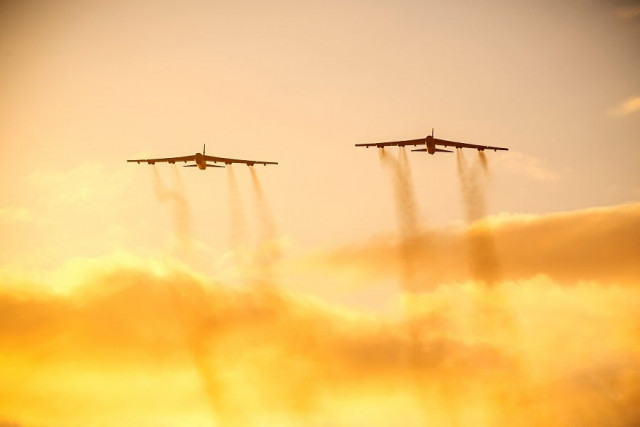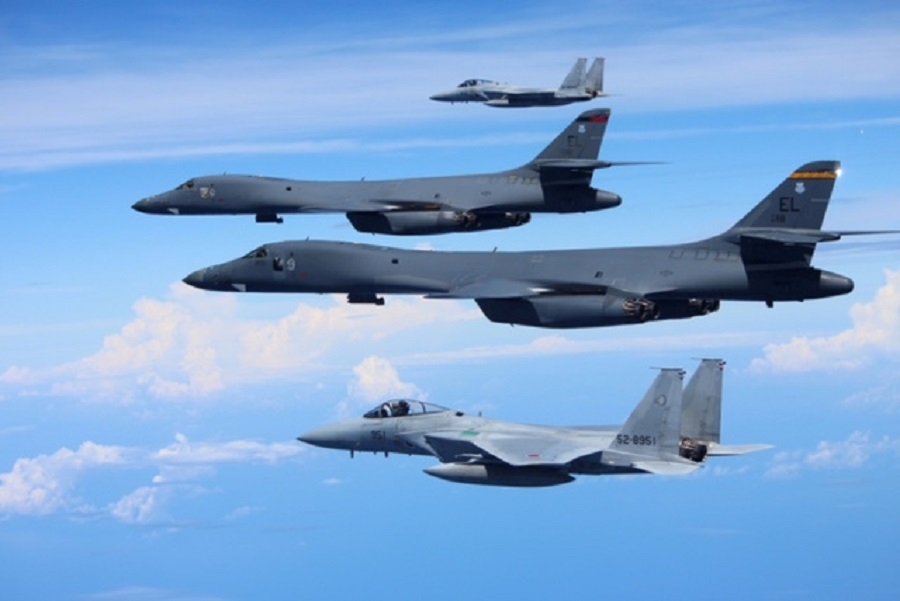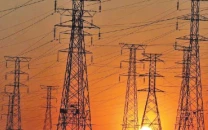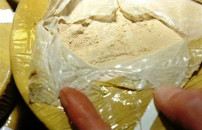Pentagon's latest salvo against China's growing might - Cold War bombers
Chinese, western military strategists warn that conflict between 2 nuclear-armed powers could be difficult to contain

On July 21, two US Air Force B-1B bombers took off from Guam and headed west over the Pacific Ocean to the hotly contested South China Sea. The sleek jets made a low-level pass over the aircraft carrier USS Ronald Reagan and its escorting fleet, which was exercising nearby in the Philippines Sea, according to images released by the US military.
The operation was part of the Trump administration’s intensifying challenge to China’s ruling Communist Party and its sweeping territorial claims over one of the world’s most important strategic waterways.
While senior Trump officials launch diplomatic and rhetorical broadsides at Beijing, the US Defense Department is turning to the firepower of its heavily armed, long-range bombers as it seeks to counter Beijing’s bid to control the seas off the Chinese coast.
Since late January, American B-1B and B-52 bombers, usually operating in pairs, have flown about 20 missions over key waterways, including the South China Sea, the East China Sea and the Sea of Japan, according to accounts of these flights from US Air Force statements and official social media posts. These missions, military analysts say, are designed to send a crystal-clear signal: The United States can threaten China’s fleet and Chinese land targets at any time, from distant bases, without having to move America’s aircraft carriers and other expensive surface warships within range of Beijing’s massive arsenal of missiles.

9th Expeditionary Bomb Squadron B-1B Lancer mechanics take selfies as a B-1B flies overhead at Andersen Air Force Base, Guam, May 21, 2020. PHOTO: REUTERS
In this response to the growing power of China’s military, the Pentagon has combined some of its oldest weapons with some of its newest: Cold War-era bombers and cutting-edge, stealthy missiles. The supersonic B1-B first entered service in 1986; the newest plane in the B-52 fleet was built during the Kennedy administration. But these workhorses can carry a huge payload of precision weapons. A B-1B can carry 24 of the US military’s stealthy new Long Range Anti-Ship Missiles, which entered service in 2018 and can strike targets at ranges of up to 600 kilometers, according to US and other Western officials.
“A single B-1 can deliver the same ordnance payload as an entire carrier battle group in a day,” said David Deptula, dean of the Washington-based Mitchell Institute for Aerospace Studies and a retired US Air Force Lieutenant General. And, in a crisis, he added, bombers can be rapidly deployed.
“Depending on where they are, ships can take weeks to get in place,” said Deptula. “But by using bombers, they can respond in a matter of hours,” he adds, noting that the US object is to deter war. “Nobody wants to engage in conflict with China.”
Chinese and western military strategists warn that a conflict between the two nuclear-armed powers could be difficult to contain.
In a clash with China, this fast response from the bomber force could be vital while the US and its allies rush naval reinforcements to the Pacific to bolster the vastly outnumbered US naval fleet stationed in the region, according to current and former US and other Western military officers.
A spokesperson for Pacific Air Forces, Captain Veronica Perez, said the US Air Force had increased its publicity about its bomber missions to assure allies and partners of Washington’s commitment to global security, regional stability and a free and open Indo-Pacific. “Though the frequency and scope of our operations vary based on the current operating environment, the US has a persistent military presence and routinely operates throughout the Indo-Pacific,” she said.
China’s defense ministry did not respond to questions from Reuters.
Lowest point
While the bomber missions continue, relations between Washington and Beijing have reached their lowest point since the 1989 Tiananmen crackdown. In a show of force, Chinese fighter jets crossed the mid-line of the Taiwan Strait while US Secretary for Health, Alex Azar, was visiting Taipei on Aug 10 to congratulate the government of President Tsai Ing-wen on its successful containment of the Covid-19 virus. Azar was the most senior American official to visit Taiwan in four decades.
Taiwan’s missile radars tracked the Chinese fighters in only the third such incursion across the median line since 2016, the Taiwanese government said. Beijing condemned the visit. It regards the island as a province of China and hasn’t ruled out the use of force to bring it under Communist Party control.
In a series of speeches ahead of Azar’s visit, top Trump officials had hammered China on multiple fronts, including its military build-up, territorial ambitions, domestic political repression, intellectual property theft, espionage, trade practices and its failure to alert the world to the danger of Covid-19.
In one of the most harshly worded attacks on China from an American official in decades, US Secretary of State Mike Pompeo said on July 23 that China’s military, the People’s Liberation Army (PLA), was not a normal fighting force.
“Its purpose is to uphold the absolute rule of the Chinese Communist Party elites and expand a Chinese empire, not protect the Chinese people,” he said. “And so our Department of Defense has ramped up its efforts, freedom of navigation operations out and throughout the East and South China Seas and in the Taiwan Strait as well.” In July, Pompeo declared most of Beijing’s claims of sovereignty over the South China Sea illegal.
With the combination of bombers and long-range missiles, the United States is trying to turn the tables on the PLA. Over more than two decades, China has assembled a force of ground, sea and air-launched missiles that would make it deadly for warships of the US Navy and its allies to approach the Chinese coast in a conflict. This Chinese strategy is specifically tailored to threaten US aircraft carrier battle groups and the network of bases that form the backbone of American power in Asia.
In a demonstration of this capability, the PLA launched one of its so-called carrier-killer missiles, the DF-26, in an exercise in the South China Sea following the deployment in July of two US aircraft carriers to the area, China’s official military media reported in early August. And a US defense official told Reuters that on Aug 26, China launched four medium-range ballistic missiles that hit the South China Sea between Hainan Island and the Paracel Islands.
But the PLA Navy’s huge and rapidly expanding fleet is also vulnerable to long-range missiles. China has built the world’s biggest navy, including new aircraft carriers, amphibious assault ships and powerful cruisers and destroyers. And the PLA’s extensive network of bases and ports would also be targets for missiles.
In a conflict, US bombers over the Western Pacific could target PLA Navy warships at their bases on the Chinese coast or underway inside the so-called first island chain, the string of islands that run from the Japanese archipelago through Taiwan, the Philippines and on to Borneo, enclosing China’s coastal seas. Chinese warships would be even more vulnerable if they broke out through the island chain into the Western Pacific, outside the coverage of the PLA’s land-based air defenses and strike aircraft.
The Firepower Gap
In the aftermath of the Cold War, Washington assumed it had uncontested control of the oceans and neglected to arm its surface fleet with modern, long-range anti-ship missiles. To be sure, the US and its allies, particularly Japan, still have a powerful fleet of attack submarines that would pose a deadly menace to PLA warships. But the bombers help fill the firepower gap in the US surface fleet while the Pentagon is re-purposing existing missiles and introducing new versions to its destroyers and cruisers, according to maritime strategists.
The bomber deployments are one element of a much wider reshaping of forces and tactics that the US and its allies in East Asia have launched to deter China from attacking Taiwan, expanding its hold over the South China Sea or seizing other disputed territories. These include the uninhabited group of isles in the East China Sea known as the Senkaku Islands in Japan and the Diaoyu Islands in China, which are claimed by both Tokyo and Beijing.
Tensions are on the rise around these islands, now under Japanese control. The commander of US forces in Japan, Lieutenant General Kevin Schneider, pledged in July that America would help Japan monitor “unprecedented” Chinese incursions into waters around the Senkakus that were challenging Tokyo’s administration. Within an hour of Schneider’s comments, China’s foreign ministry fired back that the islands were “Chinese territory.”

Long-range US bombers operating from distant airfields would remain a threat if Chinese missile attacks disabled key US bases in Japan, South Korea and Guam. These bases, mostly a carry-over from World War Two and the Korean War, were built at a time when China had very limited means to attack them.
Now it does. In a clear acknowledgement that Guam is now at risk, the US Air Force announced on April 17 it would end its continuous rotation of bombers to the island base and withdraw them to the US mainland.
‘Not like fighting Saddam’
As the risk of conflict rises, some Western airpower experts doubt that US bombers would deliver a decisive advantage in a clash with the PLA. They say the Chinese military has spent decades preparing formidable, integrated air defences. Even if the US bombers were able to sink PLA Navy warships and stealthily penetrate Chinese airspace to strike some ground targets, they say it would not necessarily translate into victory against a vast and powerful adversary.
And, they warn, it might be impossible to fight a limited conflict on China’s periphery. “It is not like fighting Saddam Hussein, it would be a major world war,” said Layton, the retired Australian air force officer. “Both sides have nuclear weapons and there is the potential for escalation. If either side is losing, what is going to happen then?”
Alongside relying on its bombers, the United States has been forced to develop other plans to offset the Chinese missile and naval threat. The US Marine Corps is planning to disperse smaller units armed with long-range anti-ship and land-attack missiles through the first island chain, where they could threaten the Chinese navy and land targets on China’s mainland.
Chinese airspace
In this networked battlefield, the Pentagon’s old warhorses of the air would be an even more formidable rival.
The speed and range of America’s Cold War-vintage bombers would allow them to approach Chinese targets from different directions and fire salvos of difficult-to-detect missiles at multiple ships, according to current and retired US air force officers. With even longer range missiles that Washington has in the pipeline, such attacks could be mounted from well outside the range of China’s powerful, land-based air defences. American bombers can also drop precision-guided mines to block strategically important ocean passages or ports.
And the US B-2 stealth bombers could penetrate more deeply into Chinese airspace and attack key targets with sharply less chance of detection than the older bombers. These bombers already carry a heavy payload of precision, land-attack munitions and could also be configured to carry the Long Range Anti-Ship Missile.
A B-1B could take off from the continental United States, refuel from tanker aircraft en route, and arrive over the Western Pacific in about 15 hours, according to Deptula and other military aviation analysts. From Hawaii the trip would take about nine hours, they say. Even closer, from northern Australia, the transit would take six hours without refuelling.
The Australian government announced in February it would spend $814 million upgrading a key air base at Tindal in the Northern Territory, including a major extension to its runway. Part of the reason for the upgrade is to support expanded US Air Force operations, the Australian government said. American bombers are already using the base.


















COMMENTS
Comments are moderated and generally will be posted if they are on-topic and not abusive.
For more information, please see our Comments FAQ